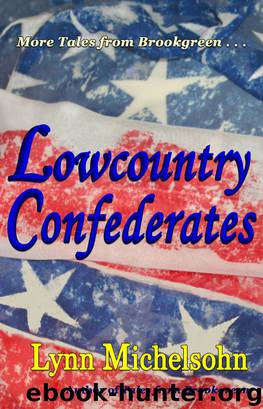Lowcountry Confederates by Lynn Michelsohn

Author:Lynn Michelsohn
Language: eng
Format: epub
Tags: war between the states, rice plantation, brookgreen gardens, murrells inlet, civil war stories, south carolina travel, confederate naval operations, myrtle beach travel, uss harvest moon
Publisher: Lynn Michelsohn
Historical Digression:
The Waccamaw Light Artillery
Cousin Corrie provided this informal history of one Confederate unit in the South Carolina Lowcountry.
As the threat of war grew more ominous during the decade of the 1850s, communities throughout South Carolina began organizing and training local militias. Men in the city of Georgetown organized the Georgetown Rifle Guards.
As war neared, three wealthy brothers organized, outfitted, and supplied their own militia group here on the Waccamaw Neck. They called their company the Wachesaw Riflemen, after the name of one of their plantations.
These brothers were sons of Colonel Joshua John Ward, who had developed big grain Carolina Gold rice at Brookgreen Plantation earlier in the century that allowed him to become the wealthiest planter in the area. The three Ward brothers now owned most of the land on the Waccamaw Neck, from Brookgreen Plantation up to the Horry County line.
Not surprisingly, the Wachesaw Riflemen elected the eldest brother, Joshua Ward, who owned Brookgreen and Springfield Plantations, as their captain. They elected his younger brother, Mayham Ward, as their First Lieutenant. The youngest brother, Benjamin Huger Ward, even returned from his studies in Edinburgh, Scotland, to accept the post of Second Lieutenant for the group.
Passage of the Ordinance of Secession in December 1860 stimulated further growth of such military units. Georgetown rice mill engineer Thomas Daggett helped organize and fund a company called the Waccamaw Light Artillery. Its members promptly elected him captain.
When actual hostilities began in April 1861 with the firing on Fort Sumter in Charleston Harbor, local militia companies began reorganizing for state service. Captain Ward’s Wachesaw Riflemen became a part of Captain Daggett’s Waccamaw Light Artillery. When Captain Daggett took on the important job of Ordnance Officer for South Carolina’s whole northern coastal district, Joshua Ward took over command of the Waccamaw Light Artillery.
As Ordnance Officer, Captain Daggett, drawing on his engineering skills, immediately set to work organizing coastal defenses from Georgetown, on Winyah Bay, sixty miles up the coast to Little River, on the North Carolina line.
With the help of gentlemen from the Hot and Hot Fish Club and their workers, he first fortified a bluff on what had been Plowden Weston’s Laurel Hill Plantation, recently acquired by wealthy North Carolinian Colonel Daniel Jordan. This fortification held two cannon and overlooked a strategic bend in the Waccamaw River. It was designed to prevent Yankee gunboats from steaming upriver and destroying rice plantations. It also protected the shipping route of boats carrying precious loads of rice downriver. To the Confederacy, rice represented both vital food supplies and a source of desperately needed hard cash when sold on the international market.
Early in the War, soldiers from the Waccamaw Light Artillery, like my father’s father, Zack Dusenberry, who served as Sergeant Major of the unit, manned this fortification. They must have had plenty of free time, perhaps days of boredom waiting for something to happen. I say this because a letter my grandfather sent home in February 1862 from Camp Weston, as they called their location, contained a long poem he had written for his young daughter.
Download
This site does not store any files on its server. We only index and link to content provided by other sites. Please contact the content providers to delete copyright contents if any and email us, we'll remove relevant links or contents immediately.
Giovanni's Room by James Baldwin(5870)
The Plant Paradox by Dr. Steven R. Gundry M.D(2035)
The Stranger in the Woods by Michael Finkel(1917)
Miami by Joan Didion(1877)
DK Eyewitness Top 10 Travel Guides Orlando by DK(1810)
Vacationland by John Hodgman(1772)
Trail Magic by Trevelyan Quest Edwards & Hazel Edwards(1757)
Wild: From Lost to Found on the Pacific Crest Trail by Cheryl Strayed(1731)
INTO THE WILD by Jon Krakauer(1719)
The Twilight Saga Collection by Stephenie Meyer(1717)
Nomadland by Jessica Bruder(1680)
Birds of the Pacific Northwest by Shewey John; Blount Tim;(1600)
Portland: Including the Coast, Mounts Hood and St. Helens, and the Santiam River by Paul Gerald(1578)
The Last Flight by Julie Clark(1487)
On Trails by Robert Moor(1474)
Deep South by Paul Theroux(1473)
Trees and Shrubs of the Pacific Northwest by Mark Turner(1423)
Blue Highways by William Least Heat-Moon(1370)
1,000 Places to See in the United States and Canada Before You Die (1,000 Places to See in the United States & Canada Before You) by Patricia Schultz(1292)
